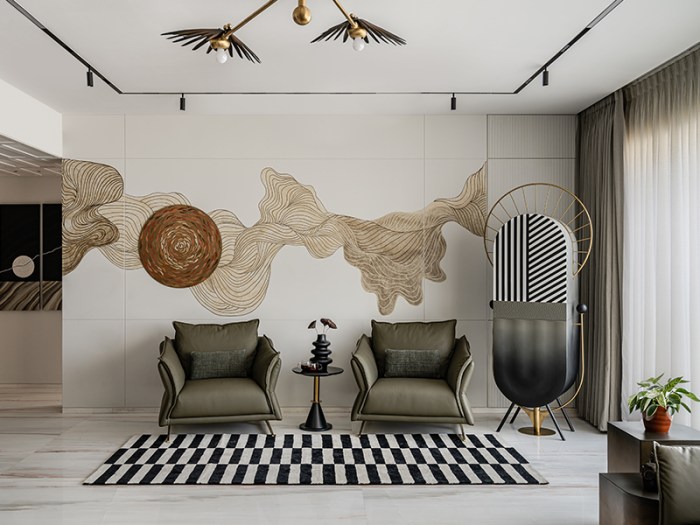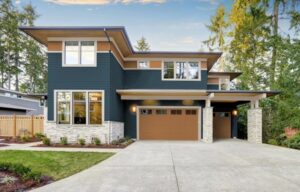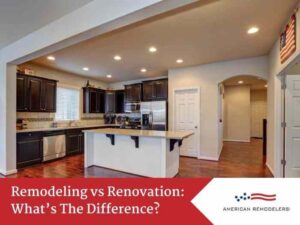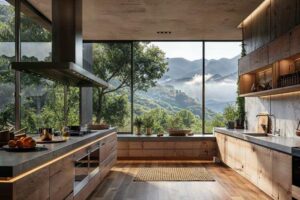
Curved furniture design trend brings a refreshing twist to contemporary interiors, inviting a seamless blend of style and comfort. From soft, rounded sofas to elegantly shaped tables, these pieces not only enhance aesthetics but also promote a feeling of warmth and relaxation, making them a favorite choice for many homeowners.
This design trend has evolved over the decades, moving from traditional forms to innovative contemporary styles, making it a staple in various interior themes. By incorporating curved furniture, spaces can transform into inviting havens, encouraging flow and fostering connections among users.
Curved Furniture Design Overview
Curved furniture design has gained immense popularity in modern interiors, serving both aesthetic and functional purposes. This design trend emphasizes organic shapes that can soften spaces and create a more inviting atmosphere. The use of curved lines in furniture contributes to a sense of flow and movement within a room, making it feel more dynamic and engaging.The significance of curved furniture design lies in its ability to complement various interior styles, from mid-century modern to contemporary.
Iconic pieces such as the Egg Chair by Arne Jacobsen and the Pear Chair by Pierre Paulin are prime examples. These pieces showcase how curves not only enhance comfort but also serve as striking focal points in any setting. Furthermore, curved furniture adapts well to various functions, whether it’s a statement armchair in a living room or a chic coffee table in a lounge area.
Evolution of Curved Furniture Design Trends
The evolution of curved furniture design has witnessed significant transformations throughout the decades, reflecting broader changes in aesthetics and technology. In the 1920s and 1930s, Art Deco introduced bold curves and luxurious materials, characterized by pieces like the curved sofa, which emphasized opulence and glamour. As we moved into the mid-20th century, the post-war period brought a shift towards more functional and minimalist designs.
The introduction of molded plywood and fiberglass allowed for innovative forms, leading to iconic designs such as the Eames Lounge Chair, which combined comfort with striking curves.In recent years, the resurgence of interest in biophilic design has further propelled curved furniture to the forefront. Designers are increasingly focusing on nature-inspired forms, where the organic shapes mimic the gentle curves found in nature.
This trend is exemplified by furniture pieces featuring rounded edges and soft silhouettes, which create a relaxed and soothing environment. In summary, the journey of curved furniture design mirrors changing societal values, technological advancements, and evolving design philosophies. It highlights the enduring appeal of curves in creating functional yet aesthetically pleasing spaces.
Benefits of Curved Furniture

Curved furniture is more than just a design trend; it offers a variety of psychological and physical benefits that enhance living spaces. Embracing curves in furniture allows for a unique approach to interior design, creating environments that promote comfort, flow, and warmth. Understanding these benefits can help homeowners and designers alike make informed decisions when furnishing their spaces.Curved furniture contributes to a more dynamic and fluid layout within a room.
Unlike traditional angular pieces, curved designs encourage ease of movement and interaction. This can be particularly beneficial in smaller living areas where maximizing space and promoting a sense of openness is essential. By eliminating sharp corners, curved furniture can promote safer navigation, especially in homes with children or elderly residents.
Psychological and Physical Benefits
Incorporating curved furniture into living spaces can significantly influence the overall atmosphere and experience. Curved forms tend to evoke feelings of softness and comfort, which can be psychologically soothing. This can enhance the mental well-being of occupants by creating a more inviting environment. Here are some key benefits:
-
Curved furniture can reduce stress and anxiety, as soft shapes are often perceived as more welcoming and less intimidating than their angular counterparts.
- It encourages social interaction, as the inviting shapes often facilitate conversation and connection among occupants.
- Curved designs can be ergonomically beneficial, as they often conform better to the natural shapes of the body, providing enhanced support and comfort.
Enhancing Flow and Movement
The flow within a room is critical to its functionality and aesthetic appeal. Curved furniture can help to enhance this flow in several ways:
- Curved pieces can guide the eye and movement around the space, creating a natural progression and reducing visual barriers.
- They can create distinct yet connected zones in an open-plan layout, allowing for varied activities without the feeling of separation.
- Curved furniture often invites users to engage in a more relaxed manner, promoting spontaneous gatherings and interactions.
Creating a Cozy Atmosphere
A cozy and inviting atmosphere is essential for any living space, and curved furniture plays a significant role in achieving this ambiance. The following elements contribute to a warm environment:
- Curved forms can soften the overall aesthetic of a room, making it feel less rigid and more approachable.
- Using curved pieces in conjunction with warm colors and textures enhances the sense of comfort and relaxation.
- They can also help in defining intimate spaces within larger rooms, creating cozy nooks perfect for relaxation or conversation.
Curved Furniture in Interior Design
Curved furniture has increasingly become a prominent feature in contemporary interior design, offering a unique blend of style and comfort. Its organic shapes not only soften spaces but also create a sense of flow that is often missing with traditional angular designs. This section delves into how curved furniture can be showcased within various interior themes, practical tips for incorporating these pieces in different spatial contexts, and a comparison of their aesthetics and functionality against traditional furniture.
Visual Guide to Curved Furniture Styles
Curved furniture comes in various styles that can complement diverse interior design themes, from modern to eclectic. Here’s a visual guide to some popular styles:
- Mid-Century Modern: Characterized by sleek lines and gentle curves, this style features furniture pieces like rounded sofas and chairs with tapered legs.
- Scandinavian: Emphasizing minimalism, Scandinavian design includes curved furniture that often incorporates light woods and soft textiles to promote a cozy atmosphere.
- Art Deco: This style showcases luxurious curved furniture with bold colors and intricate details, providing a glamorous touch to interiors.
- Bohemian: Featuring a mix of patterns and textures, bohemian interiors use curved furniture pieces that may be richly upholstered and vibrant, adding a whimsical feel.
- Contemporary: Modern designs flaunt clean lines and subtle curves, often using materials like metal and glass to create striking visual effects.
The wide variety of styles allows homeowners to select curved furniture that aligns with their personal taste and the overall theme of their space.
Tips for Integrating Curved Furniture in Different Spaces
Integrating curved furniture effectively requires consideration of the space and design intentions. Here are some useful tips for both small and large spaces:
- Small Spaces: Opt for multi-functional pieces, such as a curved sofa bed or an ottoman that doubles as a coffee table. Light colors can create an illusion of spaciousness.
- Large Spaces: Use larger curved sofas or sectionals to create a cozy conversation area. Pair them with round coffee tables to enhance the flow.
- Flow and Movement: Ensure that the curved furniture allows for easy movement throughout the space, avoiding overcrowding or obstructing pathways.
- Layering Textures: Combine curved pieces with various textures like soft pillows and throws to add warmth and comfort to the environment.
- Focal Points: Position a striking curved piece, such as a sculptural chair or a bold sofa, as a focal point to draw attention and anchor the room.
These tips emphasize the importance of balancing aesthetics with functionality when integrating curved furniture into different sized spaces.
Comparison of Traditional Furniture and Curved Designs
Curved furniture not only stands out aesthetically but also offers functional advantages compared to traditional straight-line designs. Here’s a breakdown of their differences:
| Aspect | Traditional Furniture | Curved Furniture |
|---|---|---|
| Aesthetics | Usually features sharp angles and straight lines, which can create a more formal look. | Emphasizes fluid shapes that add softness and warmth to a space. |
| Comfort | May lack the ergonomic support found in curved designs. | Often designed to provide better support and comfort with ergonomic considerations. |
| Space Optimization | Can sometimes lead to unutilized corners and awkward layouts. | Curved shapes can fit more naturally into corners and along walls, maximizing space. |
| Versatility | Less flexible in terms of arrangement and styling. | Easily adaptable to various layouts and can complement numerous styles. |
By weighing these aspects, homeowners and designers can make informed choices about the furniture that best meets their needs while enhancing the overall aesthetic of their interiors.
Kitchen Improvements with Curved Furniture
Curved furniture in kitchen design enhances both aesthetics and functionality, creating inviting spaces that cater to modern lifestyles. By incorporating rounded elements such as islands and seating arrangements, kitchens can become more user-friendly and visually appealing, setting the stage for culinary creativity and social interaction.
Layout Plan Featuring Curved Kitchen Islands and Seating Arrangements
Designing a kitchen layout that integrates curved furniture can transform the space into a more cohesive and flowing environment. A well-planned curved kitchen island not only serves as a central hub for meal preparation but also fosters interaction. For instance, a large, semi-circular island made from quartz or granite can provide ample workspace while offering seating on the outer edge, perfect for casual dining or entertaining guests.To visualize, consider a layout where:
- The curved island is positioned centrally, allowing for easy movement around the kitchen.
- Bar stools with soft, ergonomic designs are placed along the curve, ensuring comfort while encouraging conversations.
- The island might also incorporate under-counter storage for pots, pans, and kitchen gadgets, with the curve facilitating easy access from all angles.
By embracing this design, kitchens may blend functionality with a warm ambiance, ideal for both family meals and gatherings.
Practicality of Using Curved Furniture for Kitchen Storage Solutions
Curved furniture offers innovative solutions for kitchen storage, effectively maximizing space while maintaining style. Traditional straight cabinets can often create dead zones in corners, but curved cabinetry can utilize these areas efficiently. Curved cabinets can be designed to wrap around corners, allowing for easy access to stored items and minimizing wasted space.Incorporating features such as:
- Pull-out shelving within curved cabinets enhances accessibility, making it simple to retrieve items without stretching or bending.
- Lazy Susans or turntables can be integrated into a curved cabinet, providing a stylish and practical method for organizing pantry items or spices.
- Floating shelves with curved edges can create an open feel while providing display space for decorative items or cookbooks.
These design elements not only enhance storage but also contribute to the overall aesthetic of the kitchen, making it feel more open and inviting.
Impact of Curved Furniture on Kitchen Workflow and Accessibility
The introduction of curved furniture significantly impacts kitchen workflow and accessibility, promoting a more efficient cooking environment. Curved layouts allow for smooth transitions between different kitchen zones—prep, cooking, and serving—reducing the distance between key areas.For example, a curved island enhances the flow between the sink, stove, and refrigerator, ensuring that home cooks can move fluidly without the hindrance of sharp corners or obstacles.
This design choice can lead to:
- Improved movement efficiency, as individuals can navigate the kitchen with ease, making it ideal for multitasking during meal preparation.
- Enhanced safety with rounded edges, minimizing the risk of bumps or injuries, particularly in homes with children.
- A more inclusive environment, as curved seating arrangements can accommodate people with mobility challenges, making the kitchen a space for everyone to gather.
Overall, curved furniture transforms kitchens into functional, accessible, and enjoyable areas for both cooking and socializing.
Landscaping and Outdoor Decorating with Curved Furniture

Curved furniture has gained popularity not only for its aesthetic appeal indoors but also for its unique application in outdoor spaces. This design concept can seamlessly integrate with the organic forms of nature, creating inviting and functional areas for relaxation and enjoyment. Using curved furniture in landscaping enhances the natural beauty of outdoor environments, transforming typical gardens and patios into vibrant living spaces.When designing outdoor seating with curved furniture, the goal is to create a harmonious blend between the furnishings and the surrounding landscape.
By incorporating organic shapes, curved furniture can serve as a focal point or a subtle complement to the natural features of a garden. This integration fosters a sense of continuity between human-made structures and the environment.
Design Concept for Outdoor Seating with Curved Furniture
Curved furniture can be strategically placed to enhance comfort and aesthetic appeal in outdoor seating areas. Consider the following ideas for creating a welcoming environment:
- Curved Sofas and Lounge Chairs: Arrange a set of curved sofas around a central fire pit or coffee table. This setup encourages conversation and creates a cozy atmosphere, perfect for gatherings.
- Curved Benches: Install curved benches along garden paths or near flower beds. These benches not only provide seating but also invite guests to pause and appreciate the beauty of the landscape.
- Dining Areas: Use a curved dining table paired with rounded chairs to create an intimate outdoor dining space. This design helps facilitate easy movement and conversation during meals.
Complementing Natural Landscaping Features
Curved furniture works exceptionally well with natural landscaping features, enhancing the overall design. It can echo the shapes of plants, trees, and water elements, creating a cohesive environment. Here are some ways to achieve this:
- Flowing Pathways: Incorporate curved furniture along winding pathways, mimicking the flow of the landscape. This approach creates a sense of adventure as guests explore the garden.
- Water Features: Place curved seats near ponds or fountains. The gentle lines of the furniture will reflect the natural curves of the water, creating a serene focal point.
- Garden Beds: Position curved benches or tables near flower beds, allowing for an unobstructed view of the blooms. This arrangement encourages visitors to sit and enjoy the surrounding beauty.
Integrating Curved Benches or Tables in Garden Spaces
Curved benches and tables can be seamlessly integrated into various garden spaces, adding both functionality and visual interest. The following concepts illustrate effective integration strategies:
- Sunken Areas: Create a sunken seating area with curved benches, surrounded by lush greenery. This design offers privacy and a sense of enclosure, making it an ideal retreat.
- Terraced Gardens: Use curved tables on different levels of terraced gardens. This setup can facilitate multi-tiered gatherings and provide different perspectives of the landscape.
- Artistic Displays: Incorporate curved furniture as sculptural elements within garden designs. For instance, a large, eye-catching curved bench can serve as both seating and a piece of art, drawing attention in a spacious garden.
“Curved furniture brings a sense of fluidity and comfort to outdoor spaces, enhancing the connection between living areas and the natural world.”
Home Lighting and Curved Furniture
The integration of lighting with curved furniture can significantly enhance the aesthetics and functionality of any living space. The soft lines and organic shapes of curved furniture invite a unique approach to lighting design, which can accentuate their beauty while creating a warm and inviting atmosphere. By employing effective lighting strategies, homeowners can highlight these design elements and improve the overall ambiance of their rooms.One of the most effective strategies for lighting curved furniture is to use a combination of ambient, task, and accent lighting.
Ambient lighting provides overall illumination, creating a balanced environment, while task lighting focuses on specific areas for functionality. Accent lighting draws attention to particular pieces of furniture or artwork, enhancing their visual appeal.
Lighting Strategies for Curved Furniture
To effectively showcase the beauty of curved furniture, consider the following lighting strategies:
- Layered Lighting: Utilize multiple light sources at different heights to create depth. This technique helps to highlight the contours of curved furniture, adding interest and dimension to the space.
- Soft, Diffused Light: Opt for fixtures that produce soft, diffused light, such as floor lamps or table lamps with fabric shades. This type of lighting can accentuate the smooth lines of curved furniture without creating harsh shadows.
- Spotlighting: Use adjustable track lighting or wall-mounted spotlights to direct light onto specific pieces of curved furniture. This method draws the eye and emphasizes unique design features.
Recommended Light Fixtures for Curved Designs
Choosing the right light fixtures is crucial in complementing the flowing lines of curved furniture. Here are some recommendations:
- Curved Floor Lamps: Look for floor lamps that feature a gentle arc or wave design to echo the forms of your furniture. These lamps can serve as both functional and artistic elements in a room.
- Sculptural Light Fixtures: Consider pendant lights or chandeliers that have organic shapes. These fixtures can create stunning focal points while harmonizing the overall aesthetic.
- Wall Sconces: Install wall sconces with soft curves to flank pieces of curved furniture. This not only enhances the furniture but also adds character to the walls.
Enhancing Mood and Functionality
Proper lighting can significantly influence the mood of a space featuring curved furniture. The right lighting can create a cozy atmosphere or energize a room depending on the intensity and color temperature of the light used. For instance, warm white light can contribute to a relaxed vibe, making the space feel inviting and comfortable.Moreover, strategically placed lighting can enhance functionality in spaces where curved furniture is used.
In a kitchen with a curved island, under-cabinet lighting can illuminate work surfaces, making meal preparation easier and safer. Similarly, in a living room, adding table lamps beside curved sofas or chairs can provide adequate reading light while also contributing to the overall design.
“Well-designed lighting is not just about visibility but also about creating an emotional connection with a space.”
New Construction Considerations
Incorporating curved furniture into new constructions presents unique design opportunities and challenges. As architects and designers increasingly embrace the aesthetic and functional benefits of curves, several key considerations come into play. Thoughtful integration of these elements ensures that the overall space feels cohesive and inviting, enhancing the user experience.The design of a new structure should harmonize with the curves of the furniture to create an inviting atmosphere.
Architectural features such as arched doorways, rounded walls, and organic shapes in ceiling designs can beautifully complement curved furniture. These elements not only enhance visual appeal but also maintain a fluidity in the space that promotes relaxation and comfort.
Design Considerations for Curved Furniture
When integrating curved furniture into new constructions, several design aspects must be considered to achieve a seamless look:
1. Spatial Dynamics
The layout should facilitate movement around curved pieces, creating an inviting and accessible environment. Open floor plans often work best, allowing for smoother transitions between areas.
2. Material Selection
Choosing materials that enhance the softness of curved furniture is key. For example, smooth finishes and soft textiles can reinforce the overall design theme, making the space feel inviting.
3. Lighting Design
Curved furniture can create interesting shadows and light patterns. Strategic placement of lighting fixtures can highlight these shapes, enhancing the room’s ambiance.
4. Proportions and Scale
It’s vital to consider the proportions of the furniture in relation to the space. Larger curved pieces can act as focal points, while smaller items can complement them without overwhelming the area.
5. Structural Support
When designing spaces with curved elements, ensure that structural supports are appropriately integrated. This may involve custom framing or reinforcements to accommodate the unique shapes.
Integrating curved furniture into architectural designs requires a careful balance of aesthetic appeal and functional space planning.
These considerations help to create a cohesive environment where curved furniture enhances the overall design rather than feeling out of place. By aligning architectural features and space planning with the characteristics of curved furniture, new constructions can achieve a harmonious balance that is both visually stunning and practical for everyday use.
Home Painting Techniques for Curved Furniture
Painting curved furniture presents a unique opportunity to enhance its natural lines and contours, creating a visually stunning piece that stands out in any room. By using specific painting techniques and color schemes, you can beautifully emphasize the curves, transforming your furniture into a true work of art. This guide will provide you with insights into effective painting strategies tailored for curved furniture, ensuring a cohesive look in your space.To achieve the best results when painting curved furniture, it is essential to consider both the techniques used and the color schemes that complement these designs.
The right approach can highlight the elegance of the curves while also blending harmoniously with your overall interior design. Here are some useful tips for emphasizing the curves and contours of your furniture:
Painting Techniques for Curved Furniture
When painting curved furniture, specific techniques can help accentuate its shape effectively. The following methods can enhance the visual appeal of your pieces:
- Use a spray gun: This method provides an even coat and allows you to maneuver around curves with ease. The fine mist of paint can settle into detailed shapes without leaving brush strokes.
- Brush technique: For those who prefer traditional methods, using a high-quality brush can work well. A round brush allows you to follow the contours more closely, ensuring coverage in intricate areas.
- Apply a primer: Priming curved furniture before painting can help the paint adhere better and prevent peeling. It also creates a smooth base that showcases the curves more effectively.
- Layering colors: Using multiple shades or a gradient effect can add depth to the curves. Start with a base color, then apply a slightly darker shade in the nooks and crannies to emphasize the shape.
Color Schemes Suitable for Curved Furniture
The color scheme chosen can dramatically influence how curved furniture is perceived within a space. Here are some suggestions for color schemes that work well:
- Monochromatic tones: Using varying shades of a single color can create a sophisticated and cohesive look. For instance, different shades of blue can enhance the flowing lines of a curved chair while maintaining a serene ambiance.
- Contrasting colors: Bold, contrasting colors can make the furniture a focal point. For example, pairing a bright yellow with soft gray walls can highlight the curves and draw attention to the piece.
- Neutral palettes: Soft beige or white hues can provide a clean backdrop, allowing the furniture’s curves to stand out without overwhelming the space.
Pairing Wall Colors with Curved Furniture Designs
Creating a harmonious space often involves marrying wall colors with the furniture designs. The following techniques can help ensure a cohesive look:
- Complementary colors: Opt for wall colors that complement the furniture. For example, if the furniture is a warm wood finish, consider cool wall colors like soft greens or blues for balance.
- Accent walls: If the furniture is a statement piece, an accent wall in a bold color can enhance its appeal. This draws the eye and creates a dynamic focal point.
- Textured finishes: Using textured wall paints can add interest and depth to the background while allowing the curves of the furniture to remain the central focus.
“Color and technique work together to highlight the beauty of curves in furniture, creating a cohesive and elegant interior space.”
Patio Deck Ideas Featuring Curved Furniture
Creating a stunning patio deck that incorporates curved furniture can revolutionize your outdoor space, blending comfort with modern aesthetics. Curved designs not only soften the visual lines of a space but also invite relaxation and social interaction. When designed thoughtfully, a patio deck can become an extension of your home’s living area, providing a stylish and functional environment for gatherings or serene escapes.Choosing the right materials for outdoor curved furniture is crucial for durability and style.
Weather-resistant materials ensure that your furniture remains beautiful and functional through various seasons. Here are some popular options that are particularly well-suited for outdoor curved furniture:
Materials for Outdoor Curved Furniture
Durability and style are essential when selecting materials for outdoor curved furniture. The following materials are commonly used and highly recommended:
- Teak Wood: Renowned for its exceptional durability and resistance to moisture, teak wood furniture boasts a natural beauty that can last for years with minimal maintenance. Its rich tones can enhance any patio aesthetic.
- Aluminum: Lightweight yet sturdy, aluminum is often powder-coated for added protection against the elements. Its sleek and modern look complements contemporary designs seamlessly.
- Resin Wicker: Wicker made from synthetic resin is weather-resistant and easy to clean. It mimics the classic rattan appearance while ensuring longevity and comfort.
- Stainless Steel: With a sleek finish, stainless steel furniture adds a modern edge to outdoor spaces. It is resistant to rust and corrosion, making it an excellent choice for coastal areas.
To create a patio space that maximizes comfort and style with curved seating arrangements, consider the following design ideas. These elements can enhance the overall appeal of your outdoor area, making it more inviting for family and friends.
Design Ideas for Curved Seating Arrangements
Strategically arranging curved furniture can transform your patio deck into a cozy and stylish retreat. Highlighted below are key design ideas that can elevate your outdoor experience:
- Layered Seating: Create different levels of seating with curved benches or lounge chairs. This adds depth and dimension to your space, allowing for a more relaxed atmosphere.
- Fire Pit Integration: Position curved sofas around a central fire pit. This arrangement fosters intimacy and encourages conversation, perfect for evening gatherings.
- Natural Elements: Use curved benches made from natural stone or wood, complemented by lush greenery and colorful flowers. This connection with nature enhances the serenity of your patio.
- Accent Cushions: Incorporate vibrant cushions on curved seating to provide comfort and add a pop of color. Choose weather-resistant fabrics to ensure durability.
- Defined Zones: Differentiate areas of your patio by using curved furniture to create specific zones, such as lounging, dining, or even a reading corner. This approach adds functionality while maintaining a cohesive look.
Home Remodeling and Curved Furniture
Incorporating curved furniture into home remodeling projects can significantly enhance the aesthetic appeal and functionality of a space. As homes evolve to accommodate lifestyle changes, the use of curved elements can soften the rigid lines of traditional furniture, creating a more inviting atmosphere. This trend not only adds a touch of modernity but also redefines the utility of spaces by promoting better flow and interaction.When planning a remodeling project, it is essential to consider how curved furniture can integrate seamlessly into various areas of the home.
This includes leveraging its unique shapes to enhance both aesthetics and usability. Here are some strategies for incorporating curved furniture effectively:
Strategies for Incorporating Curved Furniture
Utilizing curved furniture can transform the dynamics of any room. Here are effective strategies to consider during a remodeling project:
- Choose a Focal Point: Select a striking curved piece, such as a rounded sofa or an elegant chaise lounge, to serve as the focal point of the living area. This not only draws the eye but also encourages conversation and relaxation.
- Enhance Flow: In open-concept homes, curved furniture can define spaces without the need for walls. For instance, a curved sectional can delineate the living space from the dining area while maintaining an open feel.
- Incorporate Functional Curves: Curved furniture can serve dual purposes. Consider using a round dining table that complements curved chairs, facilitating easier movement around the table and creating an intimate dining experience.
- Blend with Existing Elements: When remodeling, ensure that the curves of new furniture harmonize with existing architectural features such as arches or rounded doorways. This creates a cohesive design throughout the home.
- Layer Textures: Mix materials with curved furniture to create depth. For example, combining upholstered curved chairs with hardwood tables can add warmth and interest to the space.
Before-and-After Transformations Featuring Curved Elements
Seeing the impact of curved furniture can be quite striking. For instance, a stark, angular living room can be transformed into a cozy retreat by replacing a square coffee table with a round one, accompanied by a curved sofa. The before-and-after visual contrast highlights how curves can soften harsh lines and create a more inviting environment.In one notable example, a dated kitchen with sharp angles and rigid cabinetry was remodeled to include a curved island.
This not only improved the kitchen’s functionality, allowing for better flow during meal preparation but also created an inviting space for family gatherings. The transformation from a confined area to an open, welcoming kitchen illustrates the significant impact that curved elements can have.
Redefining Space with Curved Furniture
Curved furniture can dynamically redefine space in any remodeled area, enhancing not just aesthetics but also functionality. Here’s how:
- Creating Zones: Curved furniture can delineate different zones in an open space without barriers, making the area feel larger and more connected.
- Encouraging Movement: The natural lines of curved furniture promote easy movement, making it simpler for individuals to navigate through spaces without feeling confined.
- Improving Comfort: Curved seating arrangements encourage social interaction and comfort, as they naturally invite people to gather and engage with one another.
- Enhancing Light and Space: Curves often reflect light more effectively than straight lines, creating a brighter and more expansive feel in a room.
Incorporating curved furniture into home remodeling projects not only beautifies a space but also enhances its functionality, making it a wise choice for any homeowner looking to refresh their environment.
Pest Control Best Practices in Relation to Furniture Design
Incorporating pest control strategies into furniture design can significantly enhance the longevity and functionality of your curved furniture. As more homeowners embrace the aesthetic appeal of curved forms, understanding how these shapes interact with pests is essential for maintaining a comfortable living space. Curved furniture not only enhances the visual flow of a room but also presents unique challenges and opportunities regarding pest management.The design of furniture can influence how pests, such as insects and rodents, navigate and inhabit spaces.
Curved edges and smooth surfaces can deter certain pests, while intricate designs can inadvertently create hiding spots. Therefore, selecting the right materials and maintaining cleanliness are crucial in pest management.
Impact of Furniture Shapes on Pest Control Strategies
The shape of furniture plays a pivotal role in pest control. Curved furniture designs can limit pest access due to fewer sharp corners and crevices where insects might hide. However, it’s essential to recognize that pests can adapt to various environments. Here are some considerations regarding the impact of furniture shapes on pest control strategies:
- Curved surfaces create fewer areas for pests to hide, making inspection and cleaning easier.
- Furniture with smooth curves prevents the accumulation of dust and debris, which can attract pests.
- Designs that minimize gaps between pieces reduce the likelihood of pest entry points.
Importance of Choosing Pest-Resistant Materials
Selecting pest-resistant materials for your curved furniture design is vital for maintaining a pest-free environment. Certain materials inherently possess characteristics that deter pests, while others can be easily damaged or affected by pests. Here are some material options and their benefits:
- Metal: Resistant to termites and other wood-boring pests. Ideal for outdoor curved furniture.
- Plastic and Resin: Naturally pest-resistant and easy to clean, making them suitable for both indoor and outdoor use.
- Composite Materials: Often treated to resist pests while providing the aesthetics of wood.
Maintenance Tips to Keep Curved Furniture Pest-Free
Regular maintenance is key to ensuring that your curved furniture remains pest-free across various environments. Implementing simple yet effective practices can help ward off unwanted guests. Consider the following tips:
- Regularly vacuum and clean around and under furniture to remove dust and debris.
- Inspect furniture regularly for signs of pests and take immediate action if any are found.
- Seal any gaps or cracks in surrounding walls or floors to prevent pest entry.
- Store furniture in a dry environment, as moisture can attract pests.
“A proactive approach to pest control not only protects your investment but also enhances the overall comfort and aesthetics of your living space.”
Home Plumbing and Curved Furniture Placement
Incorporating curved furniture into spaces that involve plumbing, such as kitchens and bathrooms, requires careful consideration of layout and functionality. Curved designs can add a modern touch and enhance the aesthetic appeal of these areas, but they must align well with existing plumbing systems to avoid complications.Plumbing layout is a crucial factor when planning for curved furniture, as these pieces can affect the accessibility and efficiency of plumbing fixtures.
For instance, a curved vanity in a bathroom should be positioned to accommodate plumbing lines that may be located against the wall or below the countertop. Ensuring that water supply and drainage are properly aligned can help maintain both the design and functionality of the space.
Functional Curved Furniture Examples for Small Bathrooms
In smaller bathrooms, the challenge is to maximize space while still incorporating stylish elements like curved furniture. Here are some examples of how curved pieces can enhance functionality without sacrificing style:
- Curved Vanities: These can fit snugly into corners, allowing for more floor space and easier movement. They often come with integrated sinks that save space and provide a modern look.
- Rounded Shower Stalls: Curved shower designs can create a more open feel in compact bathrooms, providing a seamless flow while accommodating plumbing needs efficiently.
- Curved Shelving Units: These can be placed above toilets or in corners, providing storage without taking up too much space, and they can be designed to blend effortlessly with the overall decor.
Incorporating these types of furniture ensures that spaces remain functional while embracing the benefits of curved designs. The use of plumbing fixtures should be planned carefully to ensure ease of access and maintenance, emphasizing the harmony between design and functionality.
“Integrating curved furniture into plumbing spaces requires a balance of aesthetics and practicality.”
Final Conclusion
In conclusion, the curved furniture design trend is not just a fleeting craze but a significant shift in how we approach interior design. Its ability to create inviting spaces, facilitate movement, and provide comfort makes it a timeless choice for both modern and traditional homes. Embracing this trend can redefine your living environment, making it a perfect blend of functionality and artistic expression.
Popular Questions
What are the main advantages of curved furniture?
Curved furniture offers psychological comfort, enhances movement flow in a room, and creates a cozy atmosphere.
Can curved furniture fit in small spaces?
Yes, when chosen wisely, curved furniture can optimize space and create a more inviting look in small areas.
What materials are commonly used in curved furniture?
Common materials include wood, metal, and upholstery that can be shaped into curves, providing both durability and aesthetic appeal.
How does lighting affect curved furniture design?
Lighting can accentuate the curves and contours of the furniture, enhancing its beauty and the overall ambiance of the space.
Is curved furniture suitable for outdoor spaces?
Absolutely, with the right weather-resistant materials, curved furniture can add style and comfort to outdoor areas.
:max_bytes(150000):strip_icc()/gray_cashmere-56a192a93df78cf7726c1c0d.png?w=700)






